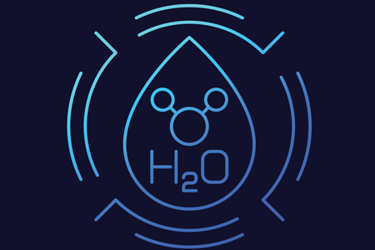Mitigating Water Concerns With A Target-Setting Framework
By Simon Gillet

The Science Based Targets Network (SBTN) recently launched its new freshwater method, developed in collaboration with sustainability consulting firm Quantis to help companies reduce their impact on water systems and build long-term resilience to climate change.
Demand for water is increasing while supply is decreasing. Reservoirs such as Lake Mead, the largest reservoir in the U.S., are drying up at alarming rates. A diminishing water supply is not only a substantial source of operational and supply chain disruption for American businesses, but it also leads to increased costs. The average price of water increased by 60% in the 30 largest U.S. cities between 2010 and 2019.
Water scarcity has caused many power station shutdowns, including a major California hydroelectric power plant that was forced to shut down for the first time since it opened in 1967. Low water levels are also disrupting major shipping routes, and cities nationwide are tightening regulations and announcing water restrictions.
These disruptions have an economic cost, and the financial losses linked to water challenges are substantial. Shipping jams caused by low Mississippi River water levels were estimated to cost $20 billion. In 2018, global companies suffered $38.5 billion in water-related losses. In 2022, depleted and contaminated water supplies led to $13.5 billion of stranded assets across four major industries (oil and gas, electric utilities, coal, and metals and mining).
According to a recent research note published by analysts at Barclays, the consumer staples sector is most vulnerable to water risk and faces a $200 billion impact from water scarcity. This is largely linked to the sector’s dependence on agricultural commodities, which are highly vulnerable to fluctuations in the price of water and disruptions from droughts and flooding.
SBTN Guidance
The Science Based Targets Network has laid out a five-step process that companies can follow to supplement their current strategy for addressing environmental issues or to begin exploring for the first time. The first version of the freshwater guidance covers the first three steps (assess; interpret and prioritize; and measure, set, and disclose) in SBTN’s five-step target-setting framework. The five steps are:
1. Assess
- Screen for material issues
- Estimate pressures.
2. Interpret and prioritize
- Determine target boundaries
- Interpret and rank
- Prioritize
- Evaluate feasibility and strategic interest
3. Measure, set, and disclose
- Measure baseline
- Develop monitoring plan
- Disclose baseline
- Set targets
4. Act
- Avoid impacts from happening in the first place
- Reduce impacts
- Restore ecosystems and regenerate ecological productivity
- Transform by taking actions that contribute to systemwide change and alter the drivers of nature loss
5. Track
- Monitor
- Report
- Verify
This freshwater methodology will enable companies to address quantity and quality, specifically surface water flows, groundwater levels, and nutrient pollution (nitrogen and phosphorus). At this stage, targets can only be set for a company’s operations and upstream value chain. Downstream guidance is currently being developed and will be available in the future.
Protect Your Water Supply
Companies that begin to develop strategies sooner rather than later will be better resourced to respond, adapt, and protect business interests.
Companies can’t manage what they don’t measure, so assessing and estimating value-chain-wide impacts and dependencies on water are the first place to start. They must conduct comprehensive water footprint and risk assessments using established tools to gather data and develop a list of potential issue areas and locations for target setting. SBTN offers extensive guidance to support corporate assessments. Companies can encourage and facilitate suppliers to conduct assessments of their own water usage and impacts.
Tools available to support companies in their water assessment include:
- World Wildlife Fund’s water risk filter is a screening tool to help companies and investors prioritize action on where it matters most to address water risk.
- Aqueduct was developed by the World Resources Institute to identify and evaluate water risks around the world.
- The water risk monetizer helps companies assess water-related business risks to understand the gap between what your business pays for water and the potential costs of water risks to your business.
Data from assessments can help businesses inform their strategic planning. Companies can set ambitious science-based targets using established water-related frameworks such as the science-based targets for water methodology by SBTN, enterprise water targets, and volumetric water benefit accounting. Companies can align their ambitions with what is necessary, set them for the near-term, set key performance indicators to measure progress, and prepare to disclose data.
Finally, companies must transform their internal mindset to align with their targets. In collaboration with key stakeholders such as investors, customers, sites, suppliers, and communities, businesses will need to develop clear water action plans to direct decision-making to support their set targets. Companies can innovate and consider deploying new business models, operational initiatives, and location-relevant strategies to reduce water use and pollution. They need to implement water stewardship programs that will benefit the communities they operate in to ensure continued sustainability and relationships. Implementing annual reporting on their progress and reporting publicly can maximize the potential of the collective effort.
References
- https://www.cnbc.com/2021/06/29/water-scarcity-why-some-of-the-worldsbiggest-companies-are-worried.html
- https://www.cnn.com/2021/08/06/us/lake-oroville-water-level-power-plant/index.html
- https://www.bloomberg.com/graphics/2022-mississippi-river-drought-globalimpact/#xj4y7vzkg
- https://cdn.cdp.net/cdp-production/cms/reports/documents/000/004/232/original/CDP_Global_Water_Report_2018.pdf?1554392583
- https://www.cdp.net/en/articles/media/financial-institutions-deeply-exposedto-stranded-assets-caused-by-global-water-crisis
- https://www.cnbc.com/2021/06/29/water-scarcity-why-some-of-the-worldsbiggest-companies-are-worried.html
- https://sciencebasedtargets.org/about-us/sbtn
- https://sciencebasedtargetsnetwork.org/how-it-works/assess/
- https://sciencebasedtargetsnetwork.org/how-it-works/prioritize/
- https://sciencebasedtargetsnetwork.org/how-it-works/set-targets/
- https://waterriskfilter.org/
- https://www.wri.org/aqueduct
- https://waterriskmonetizer.com/
- https://sciencebasedtargetsnetwork.org/wp-content/uploads/2020/11/ScienceBased-Targets-for-Nature-Initial-Guidance-for-Business.pdf
- https://www.wri.org/research/volumetric-water-benefit-accounting-vwbamethod-implementing-and-valuing-water-stewardship
 About The Author
About The Author
Simon Gillet is a senior sustainability expert and SBTN advisor at Quantis, which partners with leading organizations to drive sustainable transformation to operate within planetary boundaries.
